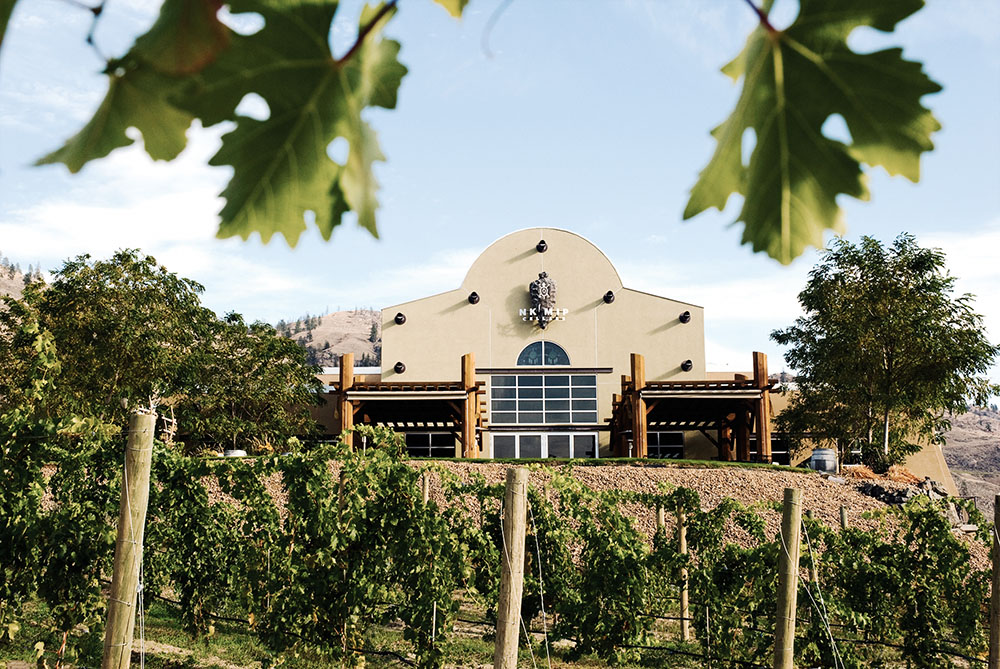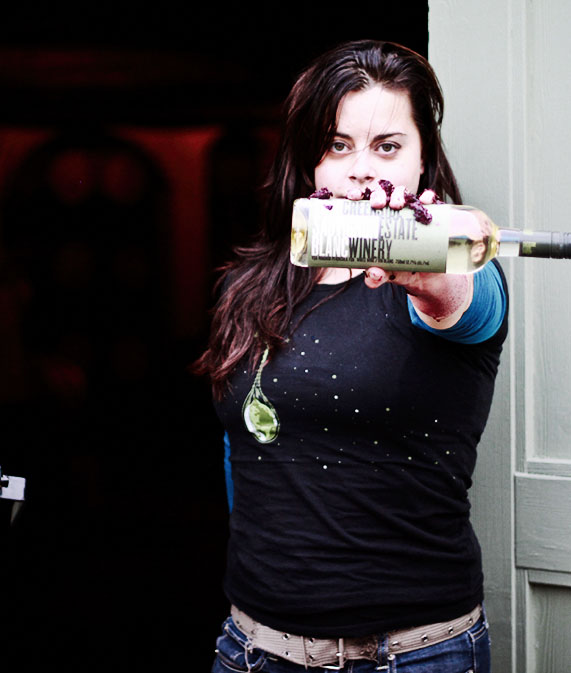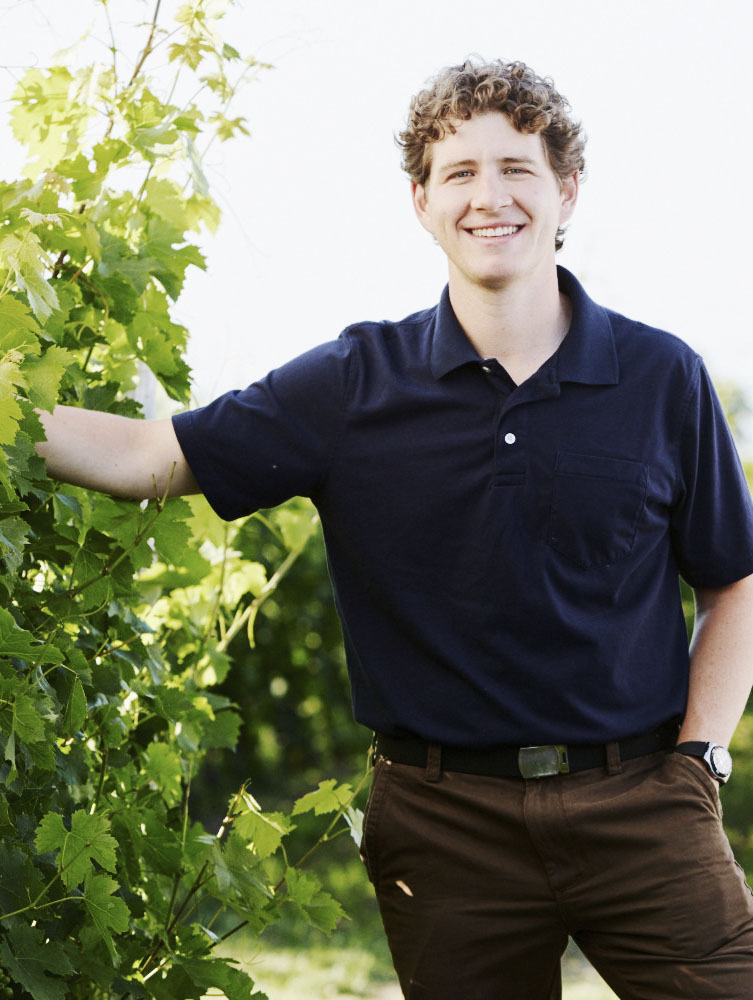
Oh boy, talk about putting the fox in charge of the hen-house! Me, a notorious carrier of an ABCer card (Anything But Chardonnay), charged with tasting and delivering to you the news about Canadian Chardonnay for this “Living Local” issue. That said, while discussing this oxymoron, one winery principal remarked that he’d rather have someone critical of the grape and the subsequent wines looking at them than one who is a slavish-fan. I hope most of you feel the same way.
I cut my teeth in the Chardonnay game with Australian and California versions. Those who suffered along with me know what I’m getting at and why I became an ABCer: oak – and too much of it, to be perfectly frank. Yup, between the Aussies and the Americans, my dream of being one of the world’s countless Chardonnay devotees was splintered into a million little shards of wood.
Of late, however, the Canadian versions I’ve tasted have slowly been whittling away at the stave that controls my hate-on for Chardonnay. But, why is Canada – of all places – having that effect on me? Shouldn’t Burgundy, with its long history and multitude of sub-regions for Chardonnay, have broken that spell? The answer is simple: Canadian Chardonnay is an affordable option, but not only that, many winemakers and winery principals are jazzed about the buzz surrounding this grape. So, I decided it was time to take a serious look at the phenomenon of Chardonnay above the 49th parallel.
“The strong point for Canadian Chardonnay is diversity,” says Justin Hall, assistant winemaker at Nk’Mip Cellars in the Okanagan, while Sophie Laurent of nearby Burrowing Owl states, “[we make] wines of great quality and distinction [and that’s] what one can expect when opening a bottle of Canadian Chardonnay.”
At Ontario’s Château des Charmes, Michele Bosc highlights adaptability in the vineyard: “We are fortunate to grow Chardonnay in this cool climate. Chardonnay is a relatively low-maintenance varietal: winter hardy, grows very well in our soil and delivers great quality at harvest time. It has adapted very well to our climate and as a result gives a delicate wine, always expressing beautifully the terroir where it is grown.” At Ontario’s Cave Spring, Gabriel DeMarco waxes poetic on the grape once harvested: “I am fascinated by Chardonnay’s adaptability in the cellar. It is a variety that the winemaker can craft into any number of styles. On one extreme, I am continually fascinated to see how it seamlessly integrates with oak, taking on structure from the wood tannins and toasty notes from time on lees, while maintaining its fruit profile and freshness. On the other hand, I also enjoy coaxing out bright aromatics that literally jump from the glass after fermentation in stainless steel. This range of style is the wonder of the grape.”
“The Canadian versions I’ve tasted have slowly been whittling away at the stave that controls my hate-on for Chardonnay.”

“The Great thing about Canadian Chardonnay is that we can make different styles that are attractive to all markets.”
As an ABCer, my thoughts always go back to one simple statement I hear, and think, more often than not: “Is there too much Chardonnay in the world? Does the world really need another?” Think about it, besides the aforementioned Americans and Aussies, there is not a corner of the winemaking world that’s not growing and producing Chardonnay. From Chile and Argentina to New Zealand, Oregon, South Africa, Washington and Italy — you name a country or a region, and there’s probably some guy or gal there toiling with Chardonnay. So, where does Canada fit in with this global grape? Is there really room for more Chardonnay – and, of all places, from Canada?
“The great thing about Canadian Chardonnay is that we can make different styles that are attractive to all markets,” says Yvonne Irving, assistant winemaker at Ontario’s Creekside Estate Winery. “Everyone knows Chardonnay – whether they are wine experts or the average Joe – and there is a style of Chardonnay for everyone.” Christie Mavety of B.C.’s Blue Mountain Vineyard and Cellars boils it down to something more simplistic: “There is always room for good-quality [Chardonnay].”
Nk’Mip’s Justin Hall points to the vineyard: “There is more room for Chardonnay grapes to be planted on sites that will show the great diversity of the grape. I think many of the poorer sites with little character to lend to the final wines need to be removed or replaced with varieties better fit to each individual site.”
Sophie Laurent at Burrowing Owl speaks to the quality Canadian Chardonnays can have, “Vine acreages in Canada are small and limited, so we can only look for the best plantings and the most qualitative vines. There is no room for mediocre or average.” Which makes Canadian Chardonnay even more special.
Derek Kontkanen, winemaker at Inniskillin Okanagan, preaches the diversity of Canadian Chardonnay: “We can find very mineral, acid-backbone styles in the cooler regions to big, ripe, juicy styles in the warmer areas. It is a great wine to showcase Canada’s diversity.” With so many reasons for the existence of Chardonnay from Canada, winemakers make a great argument for its continued success and survival here.
For those of you who have not yet picked up a bottle of Canadian Chardonnay, be it from east coast or west coast, shame on you, you truly are missing out on something special, and that comes from a man who is still straddling the fence with his ABC clamped firmly in his teeth. But Yvonne Irving explains why many of you might still be in the same boat: “We are still convincing people that we make high class wines that can stand up to wines from more well-known growing regions. Chardonnay is definitely one of those varietals for us that can prove that point. Since reintroducing Chardonnay to our Creekside portfolio, it has flown off the shelf so there is definite interest.”
From more than 100 Canadian Chardonnay submitted from across Canada, I was able to boil things down to these top 21.
Trius Barrel Fermented Chardonnay 2015, Ontario ($19.95)
Lovely aromas of peach, lime and citrus, which follow onto the palate before vanilla, butterscotch and peach cobbler notes layer in. It feels rich and creamy in the mouth, with just enough acidity to keep things honest. But what really makes this wine so special is the long finish.
Trius Oliveira Vineyard Showcase Series Chardonnay 2014, Ontario ($35)
Nose leads with buttery-vanilla and adds spiced apple while the palate offers good acidity along with peach, apple, vanilla and some jazzy, spiced-up character on the finish. At time of tasting it seemed a little tight; 6 more months should help it round out greatly.
Jackson-Triggs Arterra Chardonnay 2015, Ontario ($29.95)
Fruit comes from the old Le Clos Jordanne’s Claystone vineyard (though I am assured this is not a replacement for the now-defunct Le Clos brand), is reduced in sulfites during its making and dials back new oak usage to a minimum. The result is a fruit-forward Chardonnay on both the nose – with apple, pear and butter aromas – and palate, which follows up the smells with white fruit and buttery notes on the creamy palate before acidity swings in to refresh.
Closson Chase South Clos Chardonnay 2014, Ontario ($39.95)
16 months in 20% new oak and all estate fruit gives us some peach-vanilla and bitter/sweet notes that are delicate of spice, especially on the finish.
Meldville First Edition Chardonnay 2015, Ontario ($20)
A barrel-fermented then 6-month barrel-aged Chardonnay that is brilliant in its simplicity: creamy mouthfeel with apple and pear hanging out with melon rind, balancing acidity and a long finish that keeps you wanting more. A wine like this gets you hankering for the second edition.
Benjamin Bridge Méthode Classique Brut 2011, Nova Scotia ($44.50)
They say Nova Scotia might be the next Champagne. And, if Benjamin Bridge has anything to say about it, that might be true. Beautiful mineral/salty-like quality on the palate with biscuit and bracing acidity; crisp with lemon, lime and green apple playing on the palate. Put it beside a traditional Champagne and even the most ardent fan of the French might be fooled.
Cooper’s Hawk Chardonnay Reserve 2015, Ontario ($29.95)
From the Ontario’s Lake Erie North Shore comes one of the newest premium wineries with a stunning restaurant attached, which means they need great wine to pair with that beautiful food. Fortunately, this Chardonnay fits the bill. Only 6 months in oak so the fruit shines through: apple with hints of vanilla, lemon drop and a touch of apricot.


Burrowing Owl Chardonnay 2016, British Columbia ($35)
It seems that Chardonnay is popular across Canada, even in places where people think mostly of reds – namely the “hot” Okanagan Valley. This one is loaded with peaches and vanilla cream along with delicious apple and a lively spice-laced acidic finish that helps cleanse the palate.
Southbrook Chardonnay 2013, Ontario ($39.95)
This is a specific barrel-aged Chardonnay done in a specific type of French barrel (Allier). Those of you who think that oak is oak must try something done in a special barrel. This one is tasty as well as toasty and smoky with the smell of sweet vanilla and an odd, but welcoming, bacon note that is not something typically associated with Chardonnay. There’s also peach cobbler, apple crumble and spicy notes. The fruit hides out in the background but I expect it to come through in about 2 to 3 years.

Lightfoot & Wolfville Ancienne Chardonnay 2014, Nova Scotia ($40)
Wild fermented Chardonnay is often hit and miss with many wine drinkers: either you like that funk that the wildness puts into the wine, or you think it’s off and can’t get past the nose. There is a woody aspect to this wine but it is offset by dried and baked apple, dried apricot, vanilla cream, spice and a long finish loaded with acidity and lingering white fruits.
Westcott Estate Chardonnay 2016, Ontario ($25.95)
Westcott Vineyards is one of the newest players in the Chardonnay game in Niagara; they also focus their attention on Pinot Noir. This wine is textbook Chardonnay with lots of vanilla, apple, peach and pear aromas and flavours, there’s also plenty of buttery goodness along with a lemon meringue and floral note on the creamy finish.
Nk’Mip Qwam Qwmt Chardonnay 2015, British Columbia ($25)
Canada’s first Aboriginal winery falls under the Constellation Canada umbrella (now called Arterra Wines of Canada); they have a few Chardonnays in their lineup but none will get the Chardonnay-lover in you as happy as this one filled with peach, vanilla, dried apple, butter and elegant spices. What makes this one special is the low time in oak: 9 months, with regular lees stirring, giving the wine lovely depth.
Thirty Bench Small Lot Chardonnay 2014, Ontario ($30)
From this “house of Riesling” comes a surprising Chardonnay that’s full of depth and character. The fruit is based on apple, peach and pear while the oak delivers vanilla-caramel and creamy, buttery notes.
Inniskillin Montague Vineyard Chardonnay 2014, Ontario ($24.95)
This single-vineyard perennial favourite is one of those wines you don’t soon forget. If there was justice in the world, it would be the wine you would think of when someone says “Inniskillin” but, sadly, Icewine has taken that port-manteau. Smoked apple and canned peaches on the palate with big oak, vanilla and apple cobbler, with layer upon layer of spiced-apple flavour.
Château des Charmes Barrel Fermented Chardonnay 2015, Ontario ($14.95)
One of the best-value Chardonnays available in Ontario. There is nothing over the top here – and it has consistently been that way for as long as I can remember. It’s all here for you Chardonnay fans: apple, butter, vanilla and caramel, even some peach and a gentle spice.
Blomidon Chardonnay 2014, Nova Scotia ($25)
One of the beautiful things about Nova Scotia Chardonnay is that salty mineral aspect, which I can only assume comes off the sea and makes its way onto the grapes. What follows is mac apple and great acidity; it’s fresh and lively with plenty of fruit and a nice mid-weight creaminess that lasts all the way to the finish.
Flat Rock Chardonnay 2015, Ontario ($18.95)
Quite possibly the best base-model Flat Rock Chardonnay cobbled together to date. These are the barrels that didn’t make the winery’s top-tier Rusty Shed and that excites me for the 2015 Rusty release later this year. For now, this under-$20 version will do quite nicely. With its tropical notes, vanilla-peach and touch of spice, it comes across as complex and rich. Definitely one to get.
Kacaba Barrel Fermented Chardonnay 2015, Ontario ($30)
Kacaba seems to have an interesting honeydew note, which they have developed in this Chardonnay’s finish, but the rest is pretty typical for this style: apple cobbler, lime zest, buttery and vanilla notes with a creamy texture. But it’s that honeydew that kicks this wine up a notch.
Quail’s Gate Stewart Family Reserve Chardonnay 2015, British Columbia ($35)
If you’re going to grab yourself something from the Quail in the form of Chardonnay, this would be my choice hands down (and you have three from which to choose). It starts with a buttered-popcorn aroma, but that’s where the confection ends. Vanilla and caramel apple kick off the palate followed by peach cobbler and some spicy-ness on the finish — it’s rich, mouth-filling and very flavourful.
Creekside Queenston Road Vineyard Chardonnay 2015, Ontario ($24.95)
It has been years since Creekside made Chardonnay to speak of and then they come out with 2 back-to-back in 2014 and 2015 that set the bar high. The ’15 is a raucous little number they made from 8 barrels, aged 10 months, of which 40% was new oak. It’s fresh and lively with lots of apple, peach, pear and pineapple, subtle buttery-ness, balancing acidity and a mineral, lemon-drop finish … this one has a boatload of finesse.
Blue Mountain Chardonnay 2015, British Columbia ($20.90)
This Chardonnay is a pure delight, but what do you expect from a winery that delivers great bubbles? Here, there’s a brightness of white fruit and citrus: pear and apple meet lemon zest and grapefruit pith with subtle buttery-ness and wonderful, balancing acidity.
